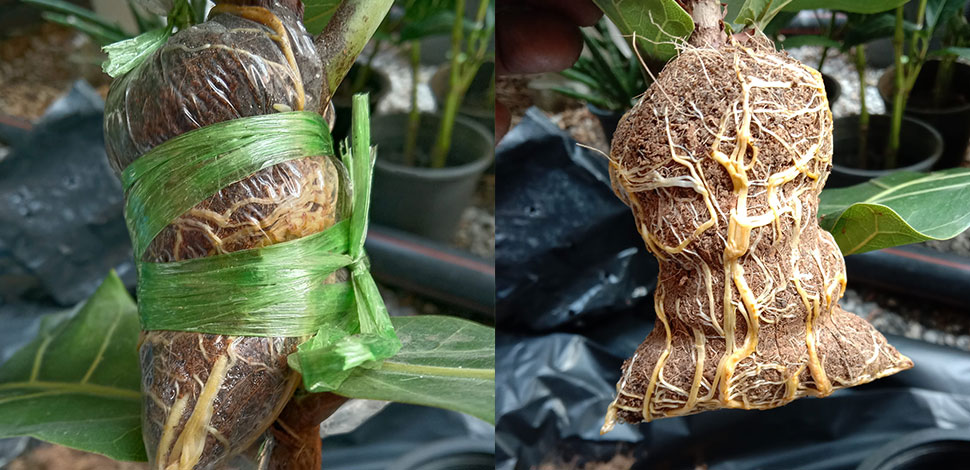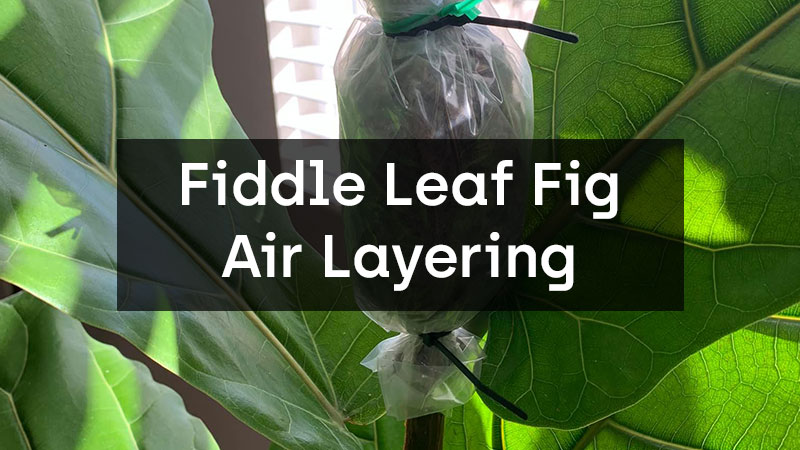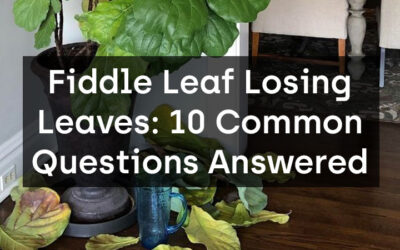Fiddle leaf figs are some of the most beautiful and popular houseplants, but they can be expensive to buy. One way to get more of these plants is to propagate them via air layering. This technique is simple, effective, and does not require much experience. In this guide, we will cover everything you need to know about fiddle leaf fig propagation via air layering.
Table of Contents
- What is Air Layering?
- Why Air Layering is a Great Way to Propagate Fiddle Leaf Figs?
- Step-by-Step Guide for Fiddle Leaf Fig Propagation via Air Layering
-
- Materials Required
- Step 1: Select a Suitable Branch
- Step 2: Prepare the Branch for Air Layering
- Step 3: Apply Rooting Hormone (Optional)
- Step 4: Pack the Cut Area with Sphagnum Moss
- Step 5: Wrap the Moss with Plastic
- Step 6: Wait for Roots to Grow (continued)
- Step 7: Potting the New Plant
-
- Tips for Successful Fiddle Leaf Fig Propagation via Air Layering
- Conclusion
- FAQs
1. What is Air Layering?
Air layering is a propagation technique that involves creating a new plant from a branch or stem of an existing plant without cutting it off from the parent plant. In this process, a branch is selected and a section of its bark is removed, and then covered with moist soil or sphagnum moss. As the branch continues to grow, new roots will emerge from the covered area, creating a new plant.
2. Why Air Layering is a Great Way to Propagate Fiddle Leaf Figs?
Air layering is a popular method for propagating fiddle leaf figs because it is a reliable and easy way to get a new plant with similar genetics as the parent plant. With air layering, you can create a new plant that is identical to the parent plant, ensuring that it has the same characteristics such as size, shape, and foliage. Additionally, air layering can be done at any time of the year, which makes it more flexible than other propagation methods.
3. Step-by-Step Guide for Fiddle Leaf Fig Propagation via Air Layering
Materials Required
- A healthy and mature fiddle leaf fig plant
- A sharp knife or pruning shears
- Sphagnum moss or a soilless mixture
- Plastic wrap or a clear plastic bag
- Twist ties or string
- A rooting hormone (optional)
Procedure
Step 1: Select a Suitable Branch
The first step in air layering is selecting a branch from your fiddle leaf fig plant that is healthy, mature, and has a diameter of at least 1 inch. It is important to choose a branch that is not too young or too old, as this can affect the success rate of the propagation. Once you have selected the branch, make sure to disinfect your cutting tool to avoid transmitting any diseases to the plant.
Step 2: Prepare the Branch for Air Layering
Use a sharp knife or pruning shears to remove a ring of bark from the selected branch, making sure to remove the bark and the cambium layer beneath it. The cut should be about 1 to 1.5 inches wide and encircle the branch completely.

Step 3: Apply Rooting Hormone (Optional)
If you have rooting hormone, you can apply it to the cut area to encourage the growth of roots. However, this step is optional and not necessary for successful air layering.
Step 4: Pack the Cut Area with Sphagnum Moss
Take a handful of sphagnum moss or soilless mixture and moisten it with water. Pack it around the cut area, making sure to cover the entire area. The moss should be about 1 to 2 inches thick, and the bottom of the moss should be about 1 inch below the cut.
Step 5: Wrap the Moss with Plastic
Wrap the moss-covered area with plastic wrap or a clear plastic bag, making sure to seal the edges with twist ties or string. This will keep the moss moist and prevent it from drying out. Make sure to leave a small opening at the top to allow air circulation.
Step 6: Wait for Roots to Grow (continued)
or watering it as needed. Check the moss periodically to ensure that it stays moist and does not dry out. Within a few weeks to a few months, you should start to see new roots growing from the cut area. Once the roots have grown to a sufficient length (about 2 to 3 inches), you can cut the branch below the rooted area using a sharp knife or pruning shears.

Step 7: Potting the New Plant
Carefully remove the plastic wrap or bag and gently remove the moss from around the roots. Plant the new fiddle leaf fig in a pot filled with well-draining potting soil, making sure to keep the soil moist and not to overwater. It is also important to provide the new plant with bright, indirect light, and to avoid exposing it to direct sunlight.
4. Tips for Successful Fiddle Leaf Fig Propagation via Air Layering
- Choose a healthy and mature branch for air layering
- Make sure to disinfect your cutting tools to prevent the spread of diseases
- Keep the moss moist and prevent it from drying out
- Place the branch in a warm and bright location, but not in direct sunlight
- Be patient and wait for the roots to grow before cutting the branch
- Plant the new fiddle leaf fig in a well-draining potting soil and provide it with bright, indirect light
5. Conclusion
Fiddle leaf fig propagation via air layering is a simple and effective way to get more of these beautiful plants. By following the step-by-step guide outlined in this article, you can create a new fiddle leaf fig plant that is identical to the parent plant, ensuring that it has the same characteristics such as size, shape, and foliage. Remember to be patient, keep the moss moist, and provide the new plant with the right conditions for growth.
6. FAQs
1. When is the best time to air layer a fiddle leaf fig plant?
Air layering can be done at any time of the year, but it is best to do it in the spring or summer when the plant is actively growing.
2. How long does it take for roots to grow using air layering?
It can take a few weeks to a few months for roots to grow using air layering, depending on the plant and growing conditions.
3. Do I need to use rooting hormone for air layering?
Rooting hormone is optional and not necessary for successful air layering, but it can help to encourage the growth of roots.
4. Can I air layer a fiddle leaf fig that is not healthy?
It is best to air layer a healthy and mature fiddle leaf fig plant to increase the chances of successful propagation.
5. How often should I water the new fiddle leaf fig plant?
Keep the soil moist but not overwatered, and water the new plant when the top inch of soil feels dry to the touch.
Read More “Propagating Fiddle Leaf Fig: Step-by-Step Guide”







0 Comments